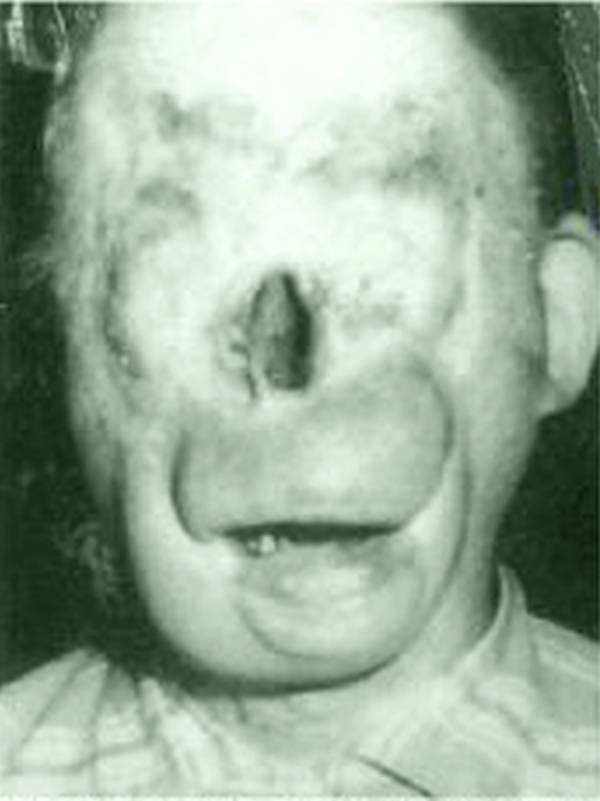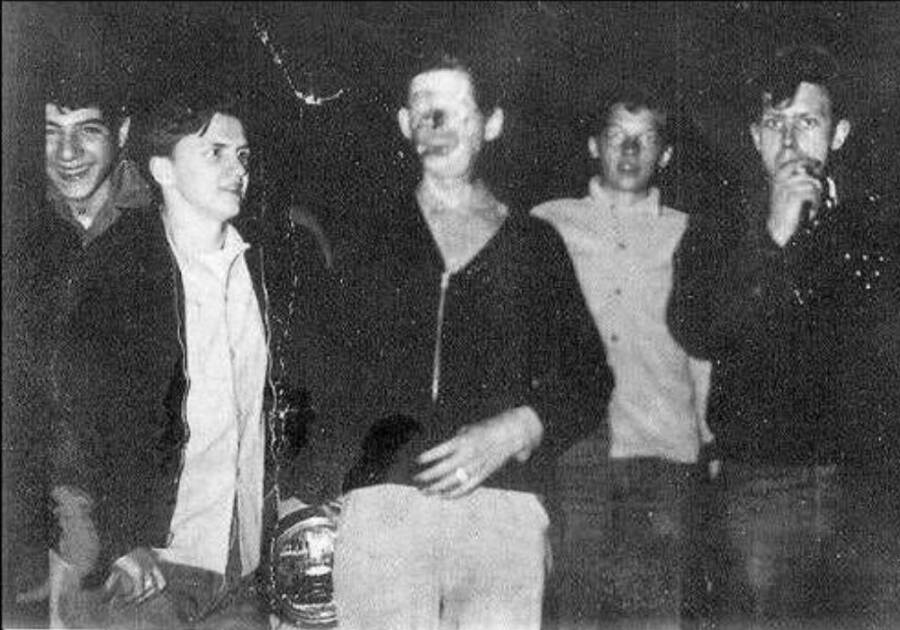After Raymond Robinson was disfigured in a childhood accident, people who saw him walking along dark Pennsylvania roads at night began spreading rumors of "Charlie No-Face" who appeared on isolated highways, sparking an urban legend that endures to this day.

Wikimedia CommonsRaymond Robinson, also known as the “Green Man” or “Charlie No-Face.”
In the 1950s, a terrifying myth began spreading across western Pennsylvania about an eerie figure who could be seen roaming dark roads at night. In reality, however, this “Green Man” wasn’t a dangerous cryptid at all: He was a local resident named Raymond Robinson.
As some versions of the urban legend went, the Green Man — also known as Charlie No-Face — was the spirit of a factory worker who fell into a vat of acid, disfiguring him and causing his spectral form to glow green. People claimed that he would chase away teenagers parked along the road and even stall cars that he touched due to an electrical “charge” he could produce.
These rumors couldn’t have been further from the truth. Robinson had been electrocuted as a child, and though he escaped with his life, he lost much of his face. As an adult, he took to going for walks after dark to avoid being seen and ridiculed for his looks. He was by no means dangerous, but his solitary nature and shocking appearance spawned the myth of a boogeyman who stalked rural State Route 351.
As such, the real story of Raymond Robinson isn’t a ghost tale. It’s the account of a quiet man who experienced a horrific childhood accident and spent his life on the fringes of society.
The Green Man Of Western Pennsylvania Legend
The urban legend of the Green Man began around the 1950s when residents driving along western Pennsylvania’s State Route 351 late at night spotted Raymond Robinson out for his evening stroll. They would tell their friends and family members about the figure without a face who appeared in their headlights and then vanished into the dark countryside — and imaginations ran wild from there.
Word spread that if one were to drive down the isolated country roads near Koppel, Pennsylvania, on a moonless night, they might spot a figure shambling along the shoulder, staying just beyond the tree line. They called him the Green Man or Charlie No-Face. He was a ghost without a face, glowing pale green in the darkness.
The stories varied, but many of them agreed on the basics: He was the spirit of a young man who had died in a terrible accident decades earlier. Some said he’d touched a downed power line during a storm. Others claimed he was struck by lightning while walking across a bridge. A few whispered that he was hit by a train, his face torn completely away.
Whatever the cause, he was supposedly cursed to wander those roads forever, a faceless specter searching for something he’d never find — perhaps his own lost reflection, perhaps peace.

RedditThe disfigured face of the “Green Man.”
Some local teenagers made a game of it, driving slowly down State Route 351 after dark, headlights cutting through the humid summer air, searching for a glimpse of the Green Man. They said he glowed with an eerie phosphorescence and that where his face should be there was only smooth, featureless skin stretched tight over bone.
No eyes. No nose. No mouth. Just a terrible, blank nothingness.
Most who claimed to have seen him said he was harmless. He simply walked, never speaking and never approaching drivers. But on certain nights, when the fog rolled in thick from the river valley, some swore they heard a low, mournful sound coming from where no mouth existed. It was a sound of longing and sorrow that followed them long after they’d driven away.
And every now and then, someone would find a beer bottle cap on the roadside or a cigarette butt that was still faintly warm and wonder: Was it really just a legend after all?
As it turned out, the answer to that question was no.
The True Story Of Raymond Robinson
While the stories about this “Green Man” deliberately chasing or scaring people were pure fabrications, the rest of his tale was fairly accurate.
According to a 1919 report in The Daily Times, Raymond Robinson was eight years old when he was shocked while reaching for a bird’s nest on a bridge. He accidentally touched a live power line, sending 11,000 volts of electricity through his body.
“[O]nly holes are left where his eyes were,” the newspaper reported at the time. “One of his hands is gone and both arms are in bad shape. The upper part of his body shows marks of serious burns.”
Prior to the incident, however, Raymond Robinson had been a normal child. He was born in Beaver County in 1910 and spent his time as any kid would have back then, hanging out with his friends and, of course, taking dares. On June 18, 1919, Robinson and several other boys were at a nearby swimming hole when they spotted a bird’s nest atop a nearby trolley bridge.

RedditRaymond Robinson sometimes spent time with the teenagers who drove out to see him.
The bridge was already known to be terribly unsafe. Just a year earlier, a 12-year-old boy named Robert Littell had been playing on the structure with some friends when he touched a live power line and subsequently died from electrical burns.
Robinson and his friends knew about the incident, but they were determined to see what was inside the nest — and Robinson was the one chosen to go look. As he climbed the bridge, however, he touched something that delivered a high-voltage shock so great that it blew off much of his face.
Doctors did not expect him to survive, yet he lived on — without his eyes, nose, and part of one arm. Reports at the time noted that he was in “good humor,” however, and that he could still hear and speak.
After he was released from the hospital, Raymond Robinson sequestered himself in his family home near Koppel, Pennsylvania, making belts, wallets, and doormats and selling them to generate a small income. He would only leave the house on walks he took in the dead of the night to avoid ridicule for his appearance.
Encounters With The Real ‘Charlie No-Face’
It was from these walks that the legend of the Green Man started to develop as high school kids spotted him from their cars on the side of State Route 351. It’s likely that the name “Green Man” came from how headlights would reflect off of Robinson’s clothing when cars passed him in the night.
One Koppel resident from the time remembered seeing Robinson on her way back to town from a swimming hole down the road. As reported by the Pittsburgh Post-Gazette in 2018, she later recalled, “I was so scared it was unreal.”

Paul Bauer/Personal PhotoRaymond Robinson in the late 1950s or early 1960s.
Though some people were frightful or cruel to Robinson, others befriended him and would bring him drinks and cigarettes for his night walks.
“We used to go out and give him beer,” another local, Pete Pavlovic, told the Post-Gazette. He noted that people would often meet at the diner he worked at before heading out to try to catch a glimpse of the Green Man.
Pavlovic added that those who didn’t know about Raymond Robinson were often shocked and terrified at the sight of him: “They wanted to call the police. You’d have to explain. Then they’d usually go back up looking for him.”
Others would sometimes offer Robinson a ride, only to drop him off at a location he didn’t know as a cruel joke on the mostly blind man. Despite this mistreatment, Robinson was a “helluva nice guy,” according to Koppel native Phil Ortega, who went to school with Robinson’s sister. Ortega remembered driving dates to see Robinson and bringing him Lucky Strikes cigarettes.
Raymond Robinson passed away on June 11, 1985, at the age of 74 from natural causes. But though he may be gone, the legend of the Green Man and Charlie No-Face is as alive today as it was in the 1950s.
After reading about the true story of Raymond Robinson, a.k.a. Charlie No-Face, learn about Bedlam, the real horror story asylum. Then, read about the scary truth behind the phantom social worker legend.





